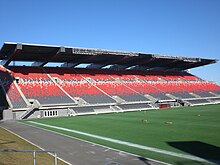Frank Clair Stadium at Lansdowne Park
 |
|
 |
|
| Former names | Lansdowne Park (1908–1993) Frank Clair Stadium (1993–2014) |
|---|---|
| Address | 1015 Bank Street |
| Location | Ottawa, Ontario |
| Owner | City of Ottawa |
| Operator | Ottawa Sports and Entertainment Group |
| Capacity | 24,000 |
| Record attendance | 51,242 (92nd Grey Cup) |
| Surface | FieldTurf |
| Opened | 1908 |
| Tenants | |
|
Ottawa Rough Riders (CFL; 1908–1996) Ottawa Gee-Gees (U Sports) Carleton Ravens (U Sports) Ottawa Giants (IL; 1951) Ottawa Athletics (IL; 1952–1954) Ottawa Junior Riders (QJFL; 1997–2006) Ottawa Renegades (CFL; 2002–2005) Ottawa Redblacks (CFL; 2014–present) Ottawa Fury FC (NASL/USL; 2014–present) |
|
TD Place Stadium (originally Lansdowne Park and formerly Frank Clair Stadium) is an outdoor stadium in Ottawa, Ontario, Canada. It is located at Lansdowne Park, on the southern edge of The Glebe neighbourhood, where Bank Street crosses the Rideau Canal. It is the home of the Ottawa Redblacks of the Canadian Football League (CFL) and the Ottawa Fury FC of the United Soccer League (USL).
The playing field has existed since the 1870s, and the complete stadium since 1908. The stadium has been host to FIFA tournaments, Summer Olympic Games, and seven Grey Cups.
The playing field, part of the Ottawa Exposition Grounds, was first cleared in the 1870s. It was used for equestrian events, lacrosse and rugby football. The first permanent grandstand was built on the north side of the playing field in 1908. It was demolished in 1967 to build a new set of stands with an integrated ice hockey arena underneath, then known as the Ottawa Civic Centre.
A small grandstand was built in the 1920s on the south-side of the field, and it was replaced in 1960. A second deck for the south-side was added during the 1970s. As of 2008, prior to lower south-side demolition, the overall stadium had a 30,927 capacity for football.
In the late 1990s, the stadium was threatened with demolition when then-city councillor (and current Ottawa mayor) Jim Watson led a drive by the municipal government to allow a private developer to reconfigure Lansdowne Park. The proposals submitted all called for residences to be built on the site of the football stadium. Massive public opposition and the realization that the end of the stadium would mean the end of hopes to return CFL football to the capital led the regional government to step in to end the scheme.
...
Wikipedia
